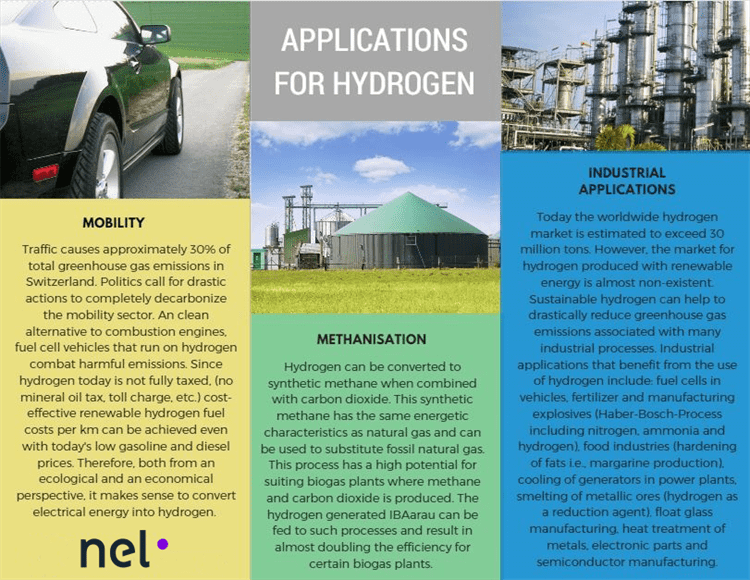Switzerland is known as the "water reservoir of Europe". Due to its topography and substantial average precipitation, the country has ideal conditions for the use of hydro power. The "run-of-the-river plant" of IBAarau in Aarau, CH is recognized as a main hydro power plant in the area, producing electricity at the site since 1895.
The IBAarau plant features 11 Kaplan turbines that generate 108 million KWh per year (12,500 KW is the average power capacity of each generator). The plant is a key tool for stakeholders who leverage renewable power.

Due to recent developments, this sustainable power source was taken a step further. A new electrolysis plant has been opened at the location after a comprehensive consideration process. The new plant is one of a kind, as it is directly linked to a hydro power plant in Switzerland. An electrolyzer (Nel Hydrogen’s C30 hydrogen generator) consumes only renewable hydro power and water, and generates hydrogen to serve a wide range of local industrial applications as well as fueling stations.
Why Hydrogen Matters
Hydrogen is a key contributor to the "energy transition", as it allows the storage of fluctuating energy and can also be used for other markets and applications. During an electricity surplus or at times of low electricity prices, renewable energy can be converted into hydrogen. The use of hydrogen (generated from renewable energy sources) provides a number of advantages, including:
- Removing exhaust gases from fossil fuel
- Enabling the reduction of CO2 emissions
- Facilitating the replacement of fossil fuels
In addition, most of the hydrogen that is generated at this site will be used to support Switzerland’s green transport. This is very beneficial because water vapor is the only emission produced by fuel cell cars. At IBAarau, the new electrolysis plant is scheduled to supply enough hydrogen in order to meet the annual consumption of around 170 fuel cell cars.
Electrolysis 101
In an electrolysis process, water is split into its constituent parts (oxygen and hydrogen) with the help of electricity. Although different forms of electrolysis technology are available, the electricity produced at the IBAarau hydro power plant is fed directly to an electrolyzer that uses Proton Exchange Membrane (PEM) technology. Compared to other types of electrolysis that require the use of caustic chemicals, PEM technology is especially remarkable as it uses only water and electricity to produce hydrogen.
At the IBAarau facility, the PEM electrolyzer rapidly adjusts to load changes and can be started and stopped immediately. A superior safety feature is provided by the high differential pressure between the gases, preventing oxygen from contaminating the stream of hydrogen gas.
Installation and Implementation
The electrolyzer can be installed easily. With regard to the hydrogen production facility, the C30 hydrogen generator from Nel Hydrogen was installed within an existing room at the IBAarau facility that earlier housed a 50 kV switchboard.
Except for the trailer filling station and the water cooling system, all of the components were located within the building. The hydro power plant generates renewable electricity that is fed into the electrolyzer to produce hydrogen. The electrolyzer plant, meant for hydrogen production, is scheduled to work 7,500 hours per year. Therefore, around 20,000 kg of hydrogen will be produced by the 200-kW facility.
The hydrogen produced will be made available (transport, storage, logistics) for a range of applications such as industrial processes, mobility, energy, housing, and so on.


This information has been sourced, reviewed and adapted from materials provided by Nel Hydrogen.
For more information on this source, please visit Nel Hydrogen.